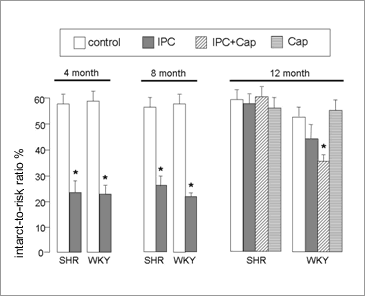Ischaemic preconditioning in progressive experimental hypertension: Interaction of left ventricular hypertrophy and ageing, and effect of ace inhibition Although in experimental left ventricular hypertrophy (LVH) the protective effects of ischaemic preconditioning (IPC) appear to be maintained, most studies have examined hearts after hypertension of short duration in young animals (Ferdinandy et al., 1998). However, ageing may be an additional factor that influences the effectiveness of IPC. The aim of this study was to characterise the effects on IPC of LVH and ageing simultaneously. Since angiotensin-converting enzyme (ACE) inhibitors enhance IPC (Baxter & Ebrahim, 2002), we also examined the action of captopril in ageing hearts. Spontaneously hypertensive rats (SHR) and age-matched normotensive Wistar-Kyoto rats (WKY) were anaesthetised with pentobarbital sodium (50 mg/kg). Excised hearts were Langendorff-perfused (WKY 80 cm H2O; SHR 100 cm H2O). The left main coronary artery was snared with a suture and occluded for 35 min followed by 120 min reperfusion. Infarct size (% of risk zone) was determined by tetrazolium staining. LVH was assessed as left ventricle/body weight ratio (LV/BW). IPC was effected by 2 x 5 min periods of global ischaemia prior to coronary occlusion. Hearts were studied at 4, 8 or 12 months of age. Additional 12 month-old hearts received treatment with the ACE inhibitor captopril (Cap) 200 μM as an adjunct to IPC.
Figure 1. Infarct size (mean ± SEM). *P<0.05 vs corresponding control group (ANOVA). n = 5-9 per group.
Progressive LVH was observed in SHR. LV/BW ratio increased relative to WKY controls by 20%, 32% and 40% at 4, 8 and 12 months respectively, but risk zone size relative to LV was similar in all groups (52-59%). Baseline coronary flow rate was matched between SHR and WKY hearts but was lower in 8 and 12 compared to 4 month-old hearts. IPC was effective in SHR and WKY hearts at 4 and 8 months but was lost in both strains by 12 months. Although Cap+IPC treatment was able to recapture a modest protection in 12 month WKY hearts, this was not seen in ageing SHR hearts. We conclude that IPC is lost in longstanding hypertension through contributions of both LVH and ageing. These findings may have implications for the clinical development of preconditioning-based therapies since longstanding hypertension is a frequent co-morbidity in patients with ischaemic heart disease.
Baxter G. F. & Ebrahim Z. (2002). Br. J. Pharmacol.135: 843-854 |
|


